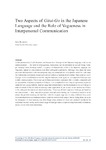Mostrar o rexistro simple do ítem
Two aspects of Gitai-Go in the Japanese language and the role of vagueness in interpersonal communication
| dc.contributor.author | Komatsu, Koji | es_ES |
| dc.date.accessioned | 2014-10-02T12:31:52Z | |
| dc.date.available | 2014-10-02T12:31:52Z | |
| dc.date.issued | 2012 | es_ES |
| dc.identifier.citation | Culture of communication / Communication of culture, 2012: 135-142. ISBN: 978-84-9749-522-6 | es_ES |
| dc.identifier.isbn | 978-84-9749-522-6 | es_ES |
| dc.identifier.uri | http://hdl.handle.net/2183/13422 | |
| dc.description.abstract | [Abstract] In this presentation, I will illustrate and discuss how Gitai-go in the Japanese language work in our communication — the field of semiogenesis, considering our development as cultural being. Gitaigo, meaning “state imitating words”, is a group of characteristic words in the Japanese language, that frequently appear in conversations and other colloquial expressions. Although they share the same structural characteristics with onomatopoeia, they are connected not with specific sound but with state, like atmosphere, movement, texture and even our subjective impression of a person. Analyzing our use of Gitai-go with a consideration to our life long development, I can figure out two aspects of Gitai-go used in daily communication. One is our use of them as primitive expression that is closely connected with our perceptions of dynamic properties of objects. It is exemplified in their frequent appearance in picture books for very young children. Another usage that appears later in our development is, to use Gitai-go in order to extend or blur the field of meaning under negotiation. It can be seen in our tactical use of them in the colloquial description of others’ personality. These two different aspects of Gitai-go are based on one characteristic — their potential to present vivid subjective feeling that is related to visual or tactile senses, though their meanings are indefinite. After the original usage seen in early childhood, they would be re-introduced into our communication to make the most of their unique feature. Using them, we avoid the emergence of clear meaning that often brings sharp contrast of values and speaker’s standpoint for evaluation. In other words, such cultural usage of Gitai-go makes us open to many behavioral or relational option in inter individual relationship. | es_ES |
| dc.language.iso | eng | es_ES |
| dc.publisher | Universidade da Coruña | es_ES |
| dc.title | Two aspects of Gitai-Go in the Japanese language and the role of vagueness in interpersonal communication | es_ES |
| dc.type | info:eu-repo/semantics/conferenceObject | es_ES |
| dc.rights.access | info:eu-repo/semantics/openAccess | es_ES |






